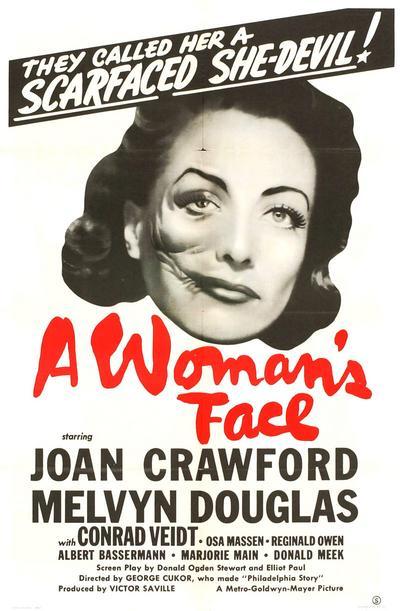Quote:
A supposedly superior remake of the 1938 Swedish film of the same name that starred Ingrid Bergman. It’s based on the French play Il etait une fois by Francis De Croisset and written by Donald Ogden Stewart and Elliot Paul. Capable studio director George Cukor (“The Women”/”Susan and God”) does his usual fine job handling actors, creating a finely drawn tense atmosphere as he makes the best of this ridiculous courtroom melodrama into a pleasing film despite the inane dialogue and incredulous machinations in the storytelling. Joan Crawford jumped at the chance to star in this juicy role despite having to play a facially disfigured woman (at least for half the film), which she was advised by even Louis B. Mayer (MGM head) that it could be costly for the glamour actress in the future. Instead it turned out to be one of her more acclaimed roles and did nothing but promote her career further as a serious dramatic actress (she won an Oscar for Mildred Pierce in 1945, which she claims this film had a cumulative effect in helping her win that award). Crawford’s scar makeup was credited to Jack Dawn, who created makeup for such films as The Wizard of Oz (1939) and Dr. Jekyll and Mr. Hyde (1941).Read More »
George Cukor
-
George Cukor – A Woman’s Face (1941)
1941-1950DramaGeorge CukorUSA -
George Cukor – Camille (1936)
1931-1940ClassicsGeorge CukorRomanceUSAMarguerite is a courtesan in Paris. She falls deeply in love with a young man of promise, Armand Duval. When Armand’s father begs her not to ruin his hope of a career and position by marrying Armand, she acquiesces and leaves her lover. However, when poverty and terminal illness overwhelm her, Marguerite discovers that Armand has not lost his love for her.Read More »
-
George Cukor – Bhowani Junction (1956)
1951-1960DramaGeorge CukorRomanceUSA

Synopsis:
The year is 1947, the British are on the verge of finally leaving India. Amongst the few who are sorry to see the British leave are the Anglo-Indians, half British and half Indian, for they are going to miss the patronage of their white cousins, the job reservations, and the important status and positions they currently hold. The British, quite frankly, do not think well of Anglo-Indians, nor do the Indians. Victoria Jones is one such Anglo-Indian, a WAC in the British Army, her father a railway engine driver, and her mom a housewife. She is close to another Anglo-Indian, Patrick Taylor, but changes her mind about him as he harbors deep hatred for the Indians. She witnesses Col. Rodney Savage instruct his soldiers to pour filthy water and garbage at the hands of untouchables on high-caste men and women who are protesting by laying down on the railway tracks to prevent trains from moving. Repulsed and shocked at this, she turns to Ranjit Singh Kassi, a Sikh, and longs to be Indian […]Read More »

